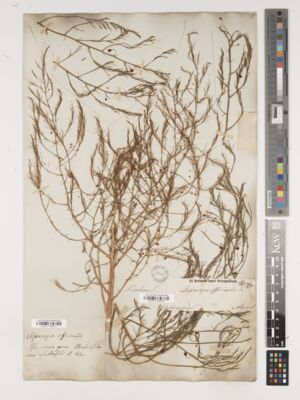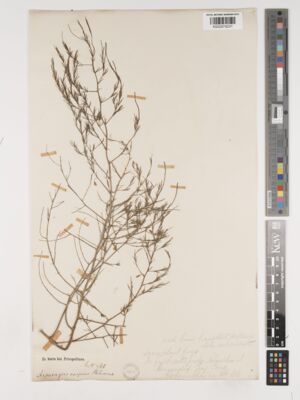Asparagus officinalis has been cultivated and harvested from the wild for thousands of years and has become an economically important crop. It is depicted on Egyptian tombs dating from the 4th century BC and evidence suggests it was cultivated in ancient Rome.
The common name asparagus derives from the Greek asparagos (and originally the Persian asparag) meaning sprout or shoot, referring to the succulent shoot tips (spears) that emerge in spring. The specific epithet officinalis means 'of the dispensary' in Latin, alluding to the medicinal properties of the plant.
In all species of the genus Asparagus, what appear to be the leaves are in fact modified stems (cladodes or phylloclades); the true leaves are the scale-like structures on the stem.
Asparagus officinalis has a long history of use as a medicinal plant. Dioscorides, a first century Greek physician, recommended extracts of asparagus root for treatment of urinary and kidney problems, jaundice and sciatica. Asparagus officinalis was later mentioned in Gerard's Herbal and was thought to 'cleanse without manifest heat and dryness' and 'increase seed and stir up lust'.
Today, it is known to be a strong diuretic and is used in the treatment of urinary problems such as cystitis. It is also useful in the treatment of rheumatic conditions, is a mild laxative and sedative, and is considered useful in the treatment of a range of maladies from arthrosis to tuberculosis. Asparagus is also a rich source of glutathione, a powerful antioxidant that is known to boost the immune system, reduce inflammation and maintain the health of the liver.
A coastal relative of garden asparagus
Some botanists recognise two subspecies of Asparagus officinalis : A. officinalis subsp. officinalis and A. officinalis subsp. prostratus . The latter has an exclusively coastal distribution and grows prostrate across dunes and coastal grassland, hence its scientific name. However, some evidence indicates that this is in fact a separate species ( Asparagus prostratus ), and it is listed as such in the World Checklist of Selected Plant Families .
Geography and distribution
Garden asparagus is native to Europe, Asia (as far east as Mongolia) and northwestern Africa (Algeria, Morocco and Tunisia).
It is grown worldwide as a crop, particularly in North and South America, China and Europe.
It grows as a non-native, introduced species in the USA, Canada, the Bermudas, the Cook Islands, French Polynesia, New Caledonia, Ecuador (including the Galapagos Islands), Japan, New Zealand, Australia and the Seychelles and is considered a persistent weed of cultivated ground.
The reduced leaves and leaf-like cladodes are adaptive features enabling asparagus plants to survive and grow in regions with seasonally dry climates.
Description
Overview: An upright herb up to 2 m tall, with a rhizome (underground stem) from which it re-grows each spring.
Leaves: True leaves are reduced to scales on the stem or spines at branching points. Green cladodes (stems, up to 25 mm long) act as leaves and are fine, flattened and produced in clusters. There are 1-10 cladodes per cluster.
Flowers: Male and female flowers are borne on separate plants. Flowers of both sexes are bell-shaped with six tepals (outer flower parts not differentiated into sepals and petals). Male flowers are 5-6 mm long and yellow. Female flowers are about 4 mm long and yellow-green. The pedicels (flower stalks) are up to 25 mm long.
Fruits: Red berries approximately 7-9 mm in diameter, containing up to six black seeds.
Seeds: Black, with a wrinkled, brittle seed coat.
Uses
The primary use of asparagus is as a vegetable, and it is widely cultivated and eaten. White spears are preferred in some regions and green spears in others. As a fresh vegetable, it is lightly boiled, steamed, blanched or grilled and often served with butter. It is mentioned in the oldest surviving book of recipes, Apicius's De Re Coquinaria .
Asparagus is not productive until the third year of growth, and its yield declines after a few seasons. This limited productivity contributes to its status as a high-value crop. Breeding and growing techniques have resulted in thicker shoots compared to wild plants, and if the growing bed is earthed up the shoots remain white. These are then excavated and cut just before they reach the surface.
Asparagus is now widely grown in South America. In arid regions in countries such as Peru there are issues surrounding the sustainability of the crop due to the excessive use of ground water and pesticides, which have a detrimental effect on the native vegetation.
Chemical constituents of Asparagus officinalis include glycosides, flavonoids and the amino acid asparagine. Eating asparagus can give a characteristic odour to the urine, due to the breakdown of compounds containing sulphur. However, not all people produce this smell, and people also vary in their ability to detect it.
Garden asparagus is sometimes grown as an ornamental, and some species are used to provide delicate greenery (asparagus fern) for floral displays.
Cultivation
Asparagus is a perennial plant and can live for up to twenty years; it benefits from good soil preparation before planting. Removal of all weeds is essential as this will be extremely difficult once the crop has been planted. Asparagus can be planted as young plants (known as crowns) or grown from seed. Growing from seed is cheaper but more labour intensive, and it can take an additional year before the first harvest is produced.
In the autumn, before crowns are to be planted, the site should be weeded and dug over. A general purpose fertiliser or well-rotted organic matter, such as well-rotted horse manure, leaf mould or compost, can be incorporated to help improve soil structure.
Crowns should be planted in April in a trench 30-45 cm wide and 35 cm deep, with well-rotted organic matter placed in the bottom 15 cm of the trench. Some excavated soil should be used to make a 10 cm high ridge along the bottom of the trench, and crowns should be placed at 35-45 cm intervals along the trench with the roots spread out as evenly as possible around the centre of the crown. Crowns should then be covered with 10 cm of soil, which should be gently firmed down and watered. The tall, above-ground stems can be supported to prevent them rocking in the wind and damaging the crowns.
Asparagus spears emerge in spring but should not be harvested in the first season after planting. This is to ensure the food generated by the asparagus top growth remains to build up the crown of the plant underground. In the second year, a light crop of spears can be taken although some recommend not taking any. Spears should be harvested when approximately 15 cm tall, cutting them just below soil level. Spears from one plant should be harvested for no more than 6-8 weeks. In Britain, shoots are harvested between the end of April and late June, and harvesting traditionally ends on Midsummer Day, 21st June. When the asparagus foliage has turned yellow in the autumn, it can be cut down to just above soil level.
Asparagus beetle ( Crioceris asparagi ) and slugs are the main pests. Asparagus beetles and their larvae can strip the outer cells (epidermis) on all above-ground parts, causing plants to turn yellow and die. They should be picked off and squashed, or treated with a pyrethrum-based spray at dusk when bees are not active. Slugs will eat emerging shoots and can be removed or controlled with nematodes or slug pellets.
This species at Kew
Asparagus officinalis can be seen growing in the Duke's Garden at Kew and in the Bog Garden at Wakehurst (in a bed north of the dipping platform).
Pressed and dried specimens of Asparagus officinalis are held in Kew's Herbarium, where they are available to researchers by appointment. Details of many other species of Asparagus can be seen online in Kew's Herbarium Catalogue.
Specimens of the seeds, fruits and roots of garden asparagus are held in Kew's Economic Botany Collection, where they are available to researchers by appointment.
























